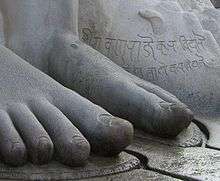Mula Sangha

| Part of a series on |
| Jainism |
|---|
 |
|
Jain prayers |
|
Ethics |
|
Major figures |
|
Major sects |
|
Festivals |
|
Pilgrimages |
|
|
Mula Sangha (Sanskrit मूलसंघ) is an ancient Jain monastic order.[1] Mula literally means the "root" or the original order.
Mula-Sangha has been the main Digambara Jain order.[2] Today the Digambar Jain tradition is synonymous with Mula Sangha. The great Acharya Kundakunda is associated with Mula Sangha. The oldest known mention of Mula Sangha is from AD 430.[3]
Mula Sangha was divided into a few branches. According to Shrutavatara of Acharya Indranandi and Nitisar of Bhattaraka Indranandi, Acharya Arhadbali had organized a council of Jain monks, and had given names (gana or sangha) to different groups. The four major groups were:
- Nandi Gana, which had two major lineages:
- Balatkara Gana, Saraswati Gachchha (oldest known mention 1071 AD)
- Deshiya Gana, Pustaka Gachchha (oldest known mention 860 AD)
- Sena Gana, the lineage of Jinasena it was formerly called Panchastupa or Surastha (oldest known mention 821 AD)
- Deva Gana, the lineage of Akalanka deva
- Simha Gana
The Bhattarakas of Shravanabelagola and Mudabidri belong to Deshiya Gana, the Bhattaraka of Humbaj belongs to the Balatkara Gana.
Several Digambara orders in North India belonged to Kashtha Sangha. There were some minor differences in practices between the Mula Sangha and the Kashtha Sangha.